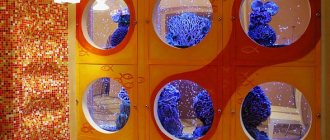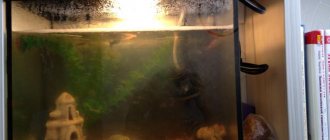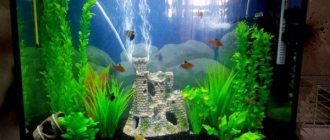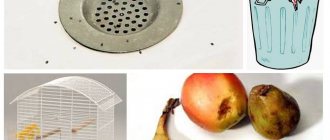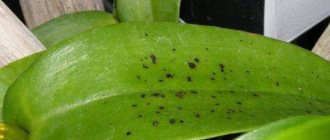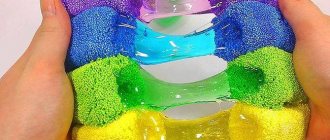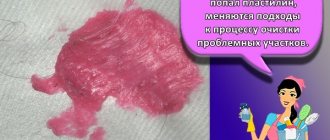Signs
Signs of ecosystem disturbance:
- cloudiness of water;
- change in color of the liquid to green and brown;
- the scenery, water surface and soil are covered with a green film or coating;
- increased content of phosphorus and nitrates;
- abundant appearance of green plaque in the aquarium.
Plaque in small quantities is considered normal. Don't be alarmed if you notice a few green dots in your aquarium. Observe the flora; if the glass becomes more green and the water becomes cloudy, this should be a cause for concern.
Video on the topic
Check out the video about green deposits in an aquarium:
Green plaque will still appear from time to time, but now you know how to deal with it. And let this be the most serious trouble that you and your fish will face. Good luck!
From time to time, plaque appears on the walls of the aquarium, which spoils the appearance and harms the inhabitants. Such mucus must be disposed of as soon as possible. There are several ways to do this - the choice depends on the type of plaque and what products are at hand.
What is needed for cleaning
To clean the aquarium you need cleaning equipment:
Clean your aquarium once a week. Cleaning is carried out in 8 stages:
How to remove brown plaque on walls
A brown coating may appear due to the development of diatoms. If it is discovered during the start-up of the aquarium and has not yet spread to the entire area, you can get rid of it by maintaining proper maintenance. In this case, they will disappear within two weeks. It is recommended to regularly clean the glass and change up to 30% of the water. With this approach, intensive development of plants will displace diatoms.
If the appearance of diatoms is detected in an existing aquarium, you should change the liquid more often, adding about a quarter of fresh water 2-3 times a week. It is also necessary to clean glass and interior decorative elements using brushes, scrapers, and sponges.
In addition, you should pay attention to the filter. For example, the filtration rate may decrease due to air pollution or contamination of the water intake system. It is also worth reducing the daylight hours to 360 minutes per day, then increasing its duration to 10 hours over 14 days. Lamps need to be changed once a year.
Residents such as Otocinclus, Theodoxus snail, Siamese algae eater, Hypostomus plecostomus, Gyrinocheilus and mollusks will also help get rid of brown algae.
Controlling diatoms with chemicals is in most cases ineffective and can worsen the situation. Using a preventative dose of algaecides will stimulate the growth of aquarium plants, which will help get rid of the problem.
How to get rid of greens in an aquarium
The use of cleansing agents is a last resort. First of all, change the living conditions of the aquarium inhabitants:
Inhabitants that help fight plaque:
How to remove green deposits on the walls of an aquarium
The cause of pollution is microscopic algae – Protococcus. As a result of their growth and development, a greenish layer of cells is formed on the inside of the walls. If it is small, this is normal and will not harm the fish in any way. But if the plaque becomes so abundant that it is impossible to see through it what is in the aquarium, it’s time to take action.
Getting rid of green algae is simple: you need to wait until Protococcus completes the process of asexual reproduction by zoospores. The cycle lasts 3 weeks. During this period, all zoospores should settle on the walls and become full-fledged cells. As a result, the unpleasant green coating will gradually lighten and die off.
After 21 days, you can clean the glass using a scraper. It is easy to get rid of the remains of dead cells with a hose equipped with a water change system.
To ensure that the situation does not repeat itself, it is necessary to analyze the reasons why Protococcus appeared and make efforts to eliminate them. Most often, green deposits appear in containers that are placed in direct sunlight. High water pH also promotes algae growth. Eliminate these causes, and plaque formation will remain within normal limits.
If you clean the glass before the end of its life cycle, it will take months to scrub off the green mass on the walls of the aquarium.
Causes
The appearance of plaque is caused by improper maintenance of the aquarium and disruption of its biological environment. Algae that creates a green coating on the walls of the aquarium:
Thermal mode
Elevated temperatures have a beneficial effect on the development of weeds. Make sure that the lamp does not heat the water too much, and in the warm season, be especially attentive to the temperature regime.
In warm water, oxygen spreads less well, chemical reactions proceed faster, stimulating the release of nitrates into the water. These substances provide food for green weeds.
Light mode
Avoid direct sunlight on the walls of the vessel. The amount and spectrum of light plays a role. In summer, daylight hours do not exceed 12 hours, in winter – 7. The walls of the aquarium turn green from the intense light of the yellow spectrum.
Large amount of feed
The food that is not removed from the bottom becomes food for the lower greens. Remove excess feed with a siphon or net.
Human waste
Together with uneaten food, waste products create conditions for the proliferation of green algae and poison the water with ammonia and nitrates.
Prevention of plaque formation on the walls and stones of the aquarium
As preventive measures that will prevent the reappearance of pests, you can apply:
- regular change of water, pre-settled for 5 days;
- control of daylight hours using backlighting, which should operate no more than 10 hours a day;
- filling the aquarium with plants and taking good care of them;
- launching fish that feed on algae;
- control of the amount of food: within 15 minutes the fish should eat all the food received; if it remains and settles on the stones, then the amount should be reduced;
It is worth fighting brown, green and brown plaque on the walls of the aquarium not only to give it an attractive appearance, but also to save the lives of the inhabitants. Algae can upset the balance of nutrients in an artificial ecosystem, and then the fish will feel uncomfortable there.
A beautiful indoor aquarium is an original addition to the interior and the pride of an aquarist. But sometimes the walls, bottom and other parts of the aquarium are covered with a green or white coating, indicating the settlement of pathogenic algae in the artificial reservoir. What to do and how to clean an aquarium at home?
The occurrence of plaque indicates an imbalance in the ecosystem. Plaque can have different shades and be located on glass, soil and stones. Before you start the fight, you need to try to find out why the walls of the aquarium turn green, indicating the appearance of pathogenic algae in the ecosystem.
If greenery constantly appears
The reasons for the appearance of green plaque are also:
Additional means are:
Green plaque on the walls of the aquarium: reasons for its appearance
The reasons that cause the appearance of a green coating on the glass of an aquarium are poorly understood and cause a lot of controversy in various forums. Layering can occur in both an old, established aquarium and a newly purchased one.
The emergence of Green Dust Algae and its active development is stimulated not by one, but by a whole group of factors. This problem is faced by reservoirs with an insufficient number of fast-growing aquarium plants or those where there are none at all. It turns out that there are a lot of nutrients, but there is no one to eat them.
A high concentration of phosphorus, exceeding 0.8 g/l, also promotes the proliferation of Protococcus. In this case, the amount of nitrogen should be no more than 5 mg/l. If nitrates are completely eliminated, blue-green algae appear.
It has also been noted that a green coating in an aquarium often occurs when the temperature rises above 27°C, daylight hours last more than 11 hours and salt concentration increases.
Indeed, as a result of treating aquarium fish with rock salt, greenery often appears on the glass.
Adviсe
To maintain the biobalance of the reservoir and proper cleaning, follow the recommendations:
- Do not use kitchen sponges or scrapers that have come into contact with detergents to clean the aquarium. Residues are dangerous for fish.
- If it is not possible to turn on and off the aquarium light at a certain time, time relays come to the rescue, which automate the change of day and night in the aquarium.
- It is better not to use metal scrapers and blades, as they leave scratches on the walls of the aquarium. Instead of a scraper, use a plastic card and thin wooden spatulas.
- If you cannot get rid of plaque on stones and decorations, soak them in bleach for 15 minutes, then pour boiling water over them.
- Avoid soil contamination due to overfeeding fish. The poured food is eaten in 5 minutes.
Under natural conditions, the water is saturated with green algae. Aquatic inhabitants eat lower plants. For herbivorous fish, greens are the basis of the diet, for others it is a necessary addition. Algae serve as a habitat for small crustaceans.
(Visited 572 times, 1 visits today)
